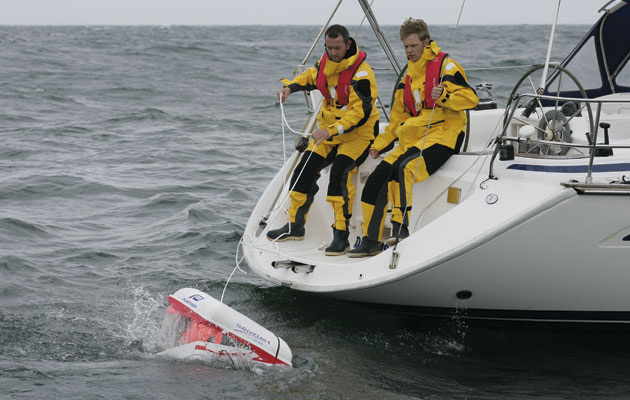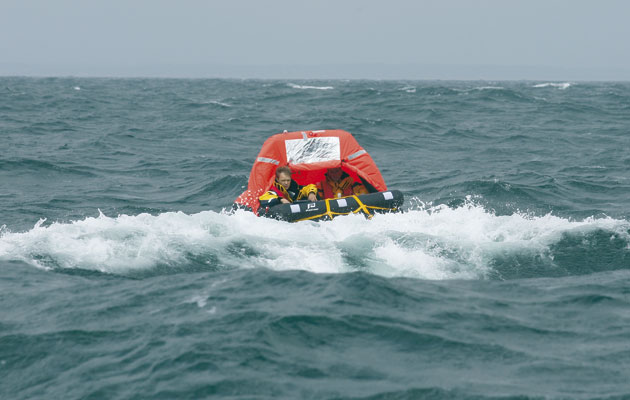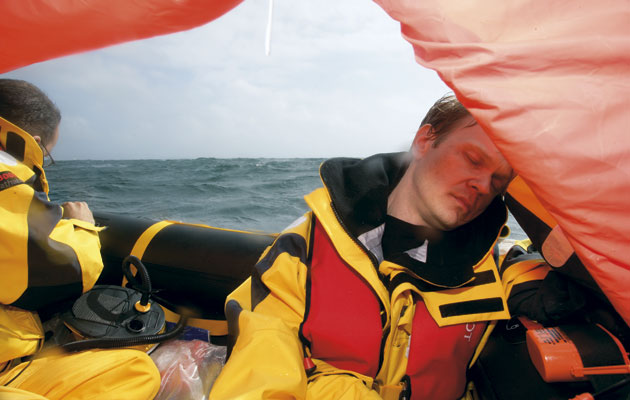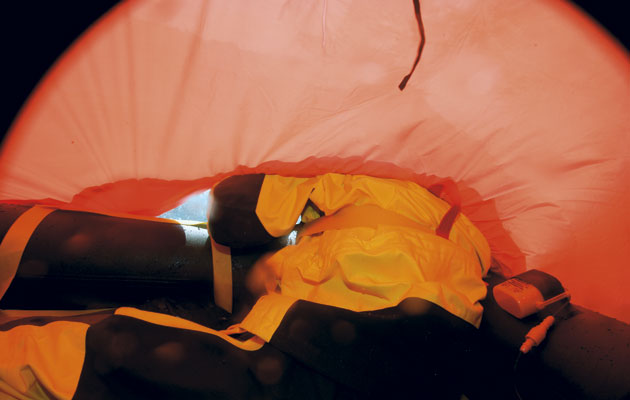Ever wondered what life in a liferaft is really like in rough weather? Yachting Monthly's Chris Beeson went to the Bay of Biscay to find out
Life in a liferaft
Most of us are familiar with the extraordinary accounts recorded by the Baileys, the Robertsons, Steve Callahan et al about surviving in liferafts for weeks and months on end. Fortunately for us, if we ever find ourselves having to abandon ship – and we’ve taken advantage of the life-saving GMDSS technology easily available to us – it’s very unlikely that we’ll be adrift for more than 24 hours, probably much less.
Though we’re familiar with the stories, few of us have ever been in a liferaft, fewer still in open waters. The aim of this test, kindly arranged by Plastimo at our request, was to find out what we might experience in that short time in a way that could never be experienced in a pool or in sheltered waters. Forewarned is forearmed.
With apologies for the low resolution…
The Bavaria 44, from which we were to ‘abandon’, rolled heavily in F5-6 winds and 2-3m seas while motorsailing into position, out of the lee and just south of Ile de Groix off Lorient on the west coast of Brittany. The main was dropped and the rolling became more pronounced as Tangi Lidec (Plastimo’s Product Manager for Safety) and I readied ourselves for the liferaft launch. We wore foul weather gear instead of the more sensible, but less realistic, option of survival suits. Below that we wore an inner layer, believing it to be too warm for a mid layer (warm enough to sweat, anyway).
On the rolling, pitching bathing platform, it became clear that one hand would be needed just to stay onboard. Having tied the painter to a strong point, we worked together to get the four-man liferaft ready to launch. The canister’s weight was a handful on the bathing platform, man-handling it from the coachroof or a cockpit locker in this sort of motion would be a major challenge.
The canister fouled slightly on the bathing platform ladder but was soon coaxed into the water. It drifted off until the red section of the painter (9m down the rope) emerged. One swift tug later, the canister burst open and the plastic bag containing the liferaft emerged and began to bulge.
Within 40 seconds, a fully inflated liferaft awaited us. We pulled it alongside the bathing platform and I jumped in. Tangi followed with the grab bag, which contained a handheld VHF, some water, warm clothing and little else. After taking one last look up at the rolling hull of the yacht, Tangi pulled out the raft’s safety knife, cut the painter and we were on our own.
I had expected the canister to fall away from the raft once inflated but a line attached one half of it. Had it not been cut away, its edge would have chafed the tubes. With that done, we settled into our new environment.
After the pitching and slamming of the yacht, the feeling onboard the liferaft was surprisingly serene – it was a calm place to be after the adrenalin rush of abandoning ship. Obviously there was no mechanical noise, no banging of rolling spars, slamming of lockers or shifting of equipment, but the wind was also considerably reduced.
On the bathing platform we had winds of F5-6, gusting 7, singing through the rigging and rumbling over our ears. In the raft, we were protected from the worst of the wind by being below the wave crests to windward. As we slowly rotated (we had yet to deploy the drogue), the canopy would crack occasionally when caught by the wind as we crested a wave. Otherwise it was very peaceful.
This sense of calm contrasted with the scene outside. This close to the water, the waves look huge and the breakers threatening. It resembled speeded-up Southern Ocean footage as the horizon changed from a few miles to a few metres in a few seconds.
The sense of calm was further enhanced by the womb-like environment. The soft surroundings and yielding floor of the liferaft rocked gently as the waves swept beneath us. It’s not an easy sensation to summarise but imagine lying on a waterbed in a tent pitched on a giant jelly.
Within minutes, that calm feeling was to deepen into a dangerous sense of apathy and nausea as the constant flexing of the raft and changing of horizon induced seasickness.
Without the drogue, the ballast bags succeeded in keeping us upright and also seemed to prevent the raft surfing downwind. Once the drogue was deployed, drift was cut significantly and the raft also became directionally more stable. Before the test, my assumption had been that the canopy would open downwind to prevent the elements invading the raft. In fact, the drogue was attached to a webbing strap to the right of the open canopy, maintaining an angle of about 30 degrees to the wind and waves.
This ensured there was a gentle flow of air through the raft and, instead of breaking waves swamping the raft as one might expect, we rode over them with remarkable ease. In a little over four hours adrift, we shipped only 4-5 breaking waves, and even then only a few litres each time.
Had it been raining, or the conditions gale or storm force, the canopy orientation would have become more of an issue. The obvious move is to close it but, as we found out, that has an almost immediate effect on well-being.
The horizon, ever-shifting as it may be, still provides a measure of orientation and the illusion of greater space. With the canopy closed, that was gone and without the airflow the atmosphere became stifling very quickly. Within 20 seconds of closure, the canopy was pulled open and the vomiting began. Again.
As night closed in, the test was brought to a close. After checking with CROSS, the French Coastguard, we fired a red handheld and the RIB approached to ‘rescue’ us. The moment we were onboard the RIB, everyone’s mood improved immediately (the RIB crew had also been seasick for several hours). We shipped and deflated the liferaft then headed back to port and a champagne reception courtesy of Plastimo.
LESSONS LEARNED
Seasickness
The most important lesson of all was the need to keep seasickness at bay. We tested various means. Tangi, a veteran of several such experiments (though not in these conditions), took no precautions. Graham the photographer (last seasick in 1999) took a handful of his trusty Kwells and I used a Reliefband, having read Nigel Calder’s recent recommendation in YM.
Immediately I began exploring the liferaft’s equipment, securing and stowing its contents around the raft, bailing and settling into the new environment. Far from nauseous, I was actually quite excited. Within a few minutes however, nausea was evident in Tangi and thereafter he became listless, apathetic, pale and clearly wished he were dead. Sitting by the open canopy, he moved only to vomit.
Then I realised that I was in a severely disabling environment with a casualty. When Graham boarded, he took pictures for 20 minutes before he had to stop because looking through the viewfinder made him nauseous. When reminded of his duties as photographer, I have to report that his usual charm abandoned him completely. I took pictures for about five minutes then stopped because there was nothing to photograph except water, sky and illness.
From being active and productive, I switched into survival mode too when I witnessed what had happened to my colleagues. I became apathetic. So enervated had we become that, in the four hours Tangi and I were onboard, neither of us drank water or ate anything, despite the obvious need to do so. Though I had no nausea and had smeared eucalyptus balm under my nose to mask the smell of vomit, I felt that any activity, other than quiet note-taking, was inappropriate. It would have felt like playing Swingball in a hospice.
It’s said seasickness has two phases: first you worry you might die, then you worry you might not. It completely transformed the entire liferaft experience. Aside from the biological aspects of losing nutrition, water and electrolytes, and the smell of vomit souring the air in the raft, there are also psychological aspects. Even those who don’t suffer are affected. The Reliefband worked well for me.
Choice of liferaft
Liferafts are expensive pieces of equipment that you hope you’ll never need to use. The temptation to buy a budget option is obvious. Resist it. If you need to deploy a liferaft, your life is already in danger. Your budget liferaft won’t seem like such a bargain if it inflates only partially, or not at all, as is occasionally the case with the cheaper, less reliable inflation mechanisms with which they are fitted.
Liferaft maintenance
Like many items of safety equipment, it’s unlikely you’ll ever need your liferaft, but when you do need it, you really need it – and your life depends on it working perfectly. As part of your regular seasonal maintenance, check the service date on your liferaft. When it needs servicing, make sure it gets it. Ask your agent if you can see the raft during service to familiarise yourself with its equipment and perhaps add a few extra useful items such as boiled sweets, any prescription medication, a waterproof notepad and pen and a spare pair of glasses if you wear them.
Canister location
As the MAIB report into the Hooligan V tragedy pointed out, the location of your liferaft is critical. Always work on the worst case scenario: inversion. Stored below, you will endanger your life by going below to retrieve it. Stored on the coachroof, you face a similar problem. Even if the raft has a hydrostatic release mechanism, it’s likely to be damaged or trapped by guardrails. Also, should you be dismasted, the coachroof is a vulnerable location (the book Total Loss recounts an incident where a shroud sliced right through the canister and its contents during dismasting).
Space
Our liferaft was a four-man. With a crew of three and a grab bag, as well as the liferaft’s equipment, there was only just room to straighten legs. With a fourth person, that wouldn’t be possible. The temptation is to buy a bigger liferaft, say a four-man raft for two crew, or a six-man for four, but bear in mind that the liferaft has been designed for maximum stability with the stated number of crew. With fewer crew, stability is compromised. Based on this experiment, in F5-6 winds and 2-3m waves, the liferaft remained stable even when there were only two crew and a light grab bag.
Motivation and morale
Motivation is inextricably linked to well-being. Seeing the condition of my fellow crew I suggested we sing a song to lighten the mood. I sang alone. Unless you can avoid seasickness, being in a liferaft on rough sea is about nothing more than survival. That said I was encouraged that, when I did give instructions, Tangi responded manfully. When we needed pictures of us both rowing the liferaft, he rowed. When we needed shots of bailing, he bailed. There was enough gumption left in him for a trace of leadership to break through the apathy. The point is that a liferaft needs an able skipper to look after the crew and to make sure what needs to be done – lookout and mother watches for instance – is done.
Drogue
Without a handheld GPS we were unable to measure our drift but, once the drogue was deployed, there would be frequent lurches as we slid down the front of a wave and the drogue’s line pulled taught, suggesting that it helps to reduce drift significantly. This is important because rescue services will target the area of your initial distress signal so the closer you can stay to it, the quicker you will be found. The drogue would also help to prevent capsize in stronger conditions than we experienced.
Bailing
As mentioned above, pervasive apathy prevented me bailing and sponging at the frequency required. With three people and an insulating matt covering the raft’s floor, creating a sink large enough to get a decent scoop was also tricky. Towards the end of the test, this apathy became self-perpetuating as the water in the raft sapped strength, heat and will. Bailing is a watch duty that must be observed to protect the crew.
Cold
Wearing just an inner and outer layer, the sun and warmth was enough for me to raise a sweat while helping Tangi to launch the liferaft from the yacht. I was anxious to avoid sweating, aware of the need to retain as much water as possible so I chose not to wear my mid-layer, stowing it instead in the grab bag. While the sun was out, warmth wasn’t a problem, but as evening approached the lack of mobility, water in the raft and general drop in temperature was sufficient for me to wear the gloves and hat I’d brought. Had the test not ended when it did, I would have needed my mid-layer. Putting it on would probably have involved getting my inner layer wet, exacerbating the heat loss problem. The rule is wear as much as you comfortably can, or as time allows you to put on, and make sure you have more layers ready.
Grab bag
In this test, our grab bag was essentially a prop. In a genuine sea survival situation, a well-prepared, easily accessible grab bag is essential. Its most important properties should be flotation and water-tightness. Some manufacturers make inflated claims about load-bearing so make sure you attach a line to test its flotation with weight inside equivalent to that of your grab bag equipment. Make sure also that the loaded bag can be carried with one hand. A lanyard with a spring clip will also mean the bag can be secured, either to the boat while preparing to abandon or to your lifejacket while abandoning. A breadboard cut to fit the bottom of the bag will stiffen its structure, improve flotation and prove useful in protecting the liferaft while using pens, knives etc.
Contents you should consider are:
GPS EPIRB
Spare handheld GPS
Spare handheld VHF
Spare batteries
Handheld compass
Compact binoculars
Spare torch
Spare multitool
Measuring jug
Non perishable glucose-based rations













